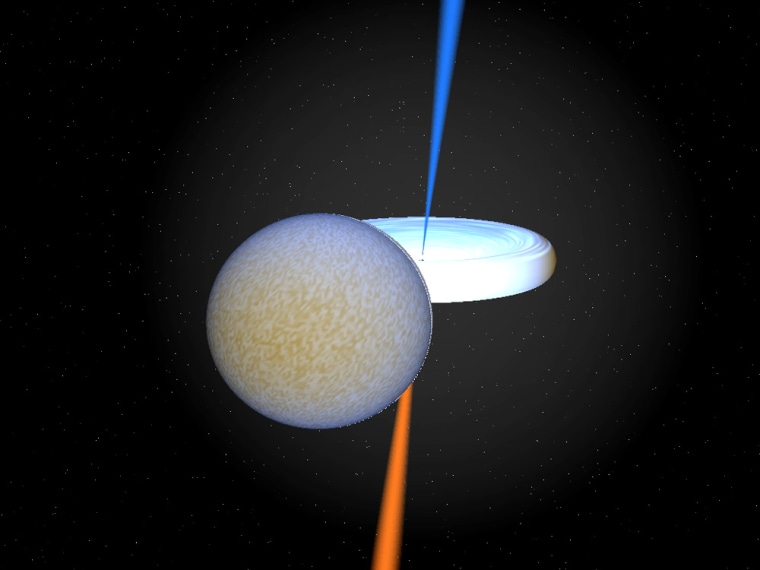Gas from a massive star is being stripped by a black hole and turned into high-speed jets that streak into space slightly less than the speed of light, according to a new study of a bizarre double-star object.
Astronomers have been fascinated and puzzled by the object, called SS 433, for 26 years because it is expelling streams of particles at more than 48,000 miles a second (77,000 kilometers per second) — a quarter of the speed of light. That's far faster than any velocities seen near other objects in the Milky Way.
SS 433 is a pair of stars which orbit a bright disc 16,000 light-years away in the constellation Aquila. Light from the central disc is dimmed every 13 days, suggesting a star was orbiting the disc and briefly blocking the light. Glare from the central disc prevented astronomers from analyzing the eclipsing star.
Dim light analyzed
An astronomy team from Georgia State University announced Monday at the national meeting of the American Astronomical Society that they have solved part of the mystery of SS 433 by capturing and analyzing light for the first time from the dim eclipsing star.
Douglas R. Gies of Georgia State said the eclipsing star is a super-giant that may be 11 times more massive than the sun. He said the star is whipping around a black hole in the center of the disc, and the gravitational force from the black hole is stripping gas away from the star at a rate that would consume the entire sun in just 10,000 years.
"The black hole is unable to digest all of the gas, and it is then ejected at incredible speeds into these jets," Gies said.
Scientists from the Massachusetts Institute of Technology analyzed the jets using an X-ray telescope. They found that gas was expelled from the disc around the black hole at a temperature of more than 100 million degrees Fahrenheit.
Herman L. Marshall of MIT said the black hole at the disc's center is only about the size of the Atlanta metropolitan area, but the mass is equal to about 16 suns. The jet would cover an area the size of the continental United States. It streaks into space for more than a million miles.
Mysterious monster
A black hole is a single point in space which is so dense with matter that it creates a gravitational force that permits nothing to escape, not even light. A disc around a black hole can be seen because matter sucked into the center is accelerated at high velocities and heated so that it gives off X-rays and light.
Bruce Margon of the Space Telescope Science Institute said SS 433 still puzzles astronomers because there is no other object like it in the universe.
"Only in SS 433 does a receiving star refuse to accept gas from a donor star and instead eject it into space," said Margon. "The accepting star just can't handle it all."
Almost 2,000 astronomers are attending the American Astronomical Society meeting and presenting some 1,200 papers.
